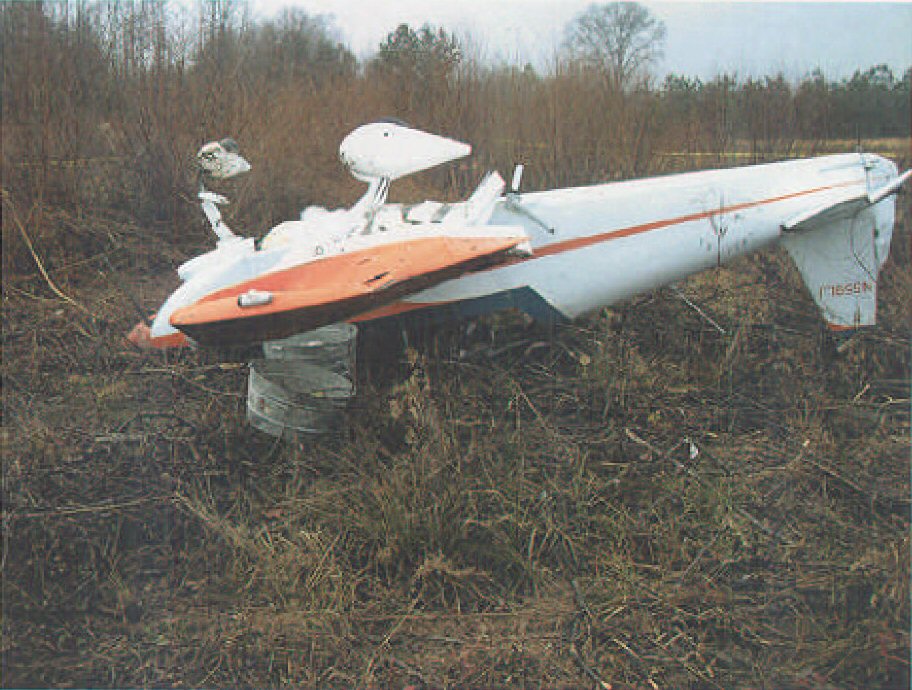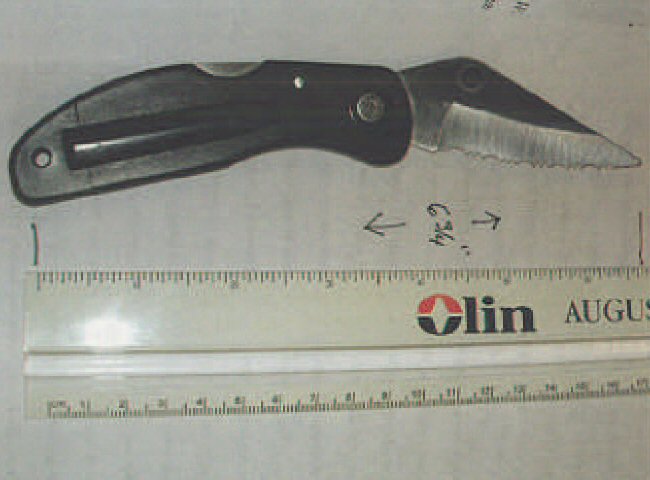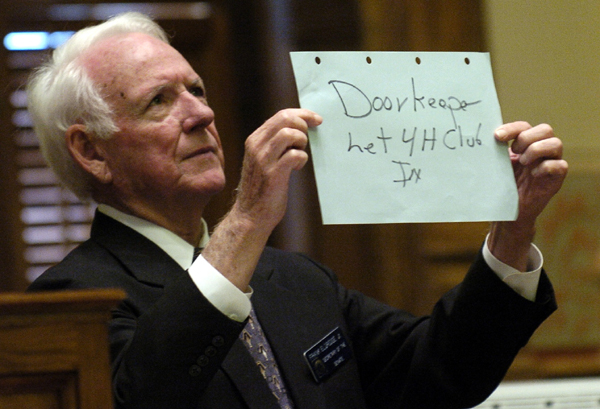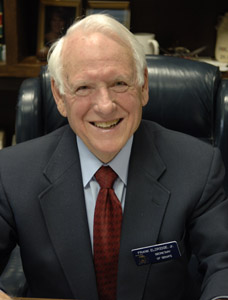
08 Oct 2005 RV6A crash and the knife that helped the pilot escape
This is a letter written by the pilot involved in this accident.
I received your letter asking for more details in my recent RV accident. I have had a number of similar requests so I will publish this on the web. It will be long but hopefully will be useful for other RV pilots.
I am 70 years of age with over 6,200 hours total time and over 100 hours in the RV6A in the last 6 months. I lost my medical three years ago because of two stints placed in my heart. My doctors, who are world class, one who was selected Nation’s Outstanding Physician of the Year, pronounced me fit to fly and to participate in any other activity I enjoyed. I have always been very active playing tennis, riding horses, and recently I rode my motorcycle to California and Nova Scotia. In a normal day’s routine, I spend an hour on the treadmill with a grade up to 12 percent and speed up to 4.0 miles an hour. My doctors say the FAA is nuts. I have offered to have any procedure that the FAA would accept to restore my medical. My doctors say for me to have any intervention would be foolish at the least, and malpractice at the worst.
I own a Duchess (BE76), but with the talk about dropping the requirements of a medical for a third class license, I bought the RV6A hoping this would happen and that the FAA would gain some sanity. For three years I hired a pilot to fly with me from Waycross, Georgia, where I live, to Atlanta, Georgia, where I work, which is about 250 mile each way. I make over 60 round trips per year, so being able to fly was a big convenience. On New Year’s Day, 2003, it was not convenient for any of my three pilots whom I normally hire to ride with me, so I flew solo on the day of the accident.
The RV6A was bought in California and I prevailed upon our local RV guru, Vern Darley, who is a former airline pilot and A&E mechanic, along with a current Delta pilot, to fly to California to inspect the RV6A and fly it to Georgia. The RV6A performed flawlessly for about 50 hours, then taxiing out on a trip to Waycross, Georgia, from Peachtree City, Georgia, it quit inexplicably on the taxiway. Being very cautious, I had the carburetor and engine driven fuel pump replaced. It ran fine for 2 round trips to Waycross, approximately 6 hours, and then quit again on the taxiway. At this time, I replaced all fuel lines, auxiliary fuel pump, and pulled the fuel selector valve for a complete inspection. At that point nothing was left in the original fuel system except the tanks.
I flew the RV6A for 40 more hours with no problems to its final flight on 1/1/03. On the final flight, I left Waycross with both tanks full of fuel, the weather was 2000 feet overcast and visiblity was good. Forty-five minutes into the flight, I switched from the left fuel tank to the right fuel tank over the Perry, Georgia, Airport, using the normal procedure of boost pump on before switching tanks and after 4 minutes, turning the boost pump off. Sixty-five minutes into the flight, I noticed the RPM had dropped 150 below the normal cruise of 2300, so I increased the RPM back up to 2300 by applying more throttle. The 0-320 engine has a fixed pitch prop, so everything returned to normal. I crossed the outer market at F.C; at the appropriate altitude I enriched the mixture, turned on the boost pump, applied carburetor heat and nosed over onto the virtual glide slope and reduced power. The engine quit abruptly, so I returned the throttle to the full open position, switched the tanks back to the left tank, turned the boost pump off for a few seconds, turned the boost pump back on, and returned the mixture back to whree it was prior to the power loss. I went through this procedure trying to get the power back on and nothing I did would bring the engine back to life.
While doing all this, I was looking for the best place to land. I knew there was a railroad on a 20 foot high embankment, perpendicular to my path that I had to cross, and I was concerned about avoiding the approach lights after crossing the railroad. I knew I could not make the runway, so I tried to find the best place to make a forced landing. The best spot had small trees and heavy brush in a swampy area. It also had a 3-foot concrete culvert that was not visible. The right wheel pant caught the culvert but I was able to make a normal landing. The brush and the mud caught the nose gear and I went over and upside down. I ended up in the luggage compartment, out of the shoulder harness and seatbelt. No bruises, no broken bones, and only a skinned forehead caused by the sunshade on the top of the cockpit. I could hear the boost pump running and was able to reach between the seats to turn off the master switch. I tried to kick the plexi glass canopy out but was unsuccessful. I took my pocketknife, which I always carry, out of my left pocket and was able to break a small hole that was large enough for me to ease out. I cut my hands on the plexi glass, which accounted for what little blood that was in the airplane.
After exiting the airplane and surveying the damage, I called Vern Darley on my cell phone. He and another RV pilot arrived in a few minutes, and we contemplated how to remove the airplane. The last airplane to arrive that day flew over us, saw the airplane upside down, and called and alerted the fixed base operator. In a few minutes the place was awash in blue lights.
The FAA arrived about an hour later and will probably make an example out of me becuase I have held a public office in Georgia since 1965. I have told my attorney to enter a guilty plea and I will pay whatever fine they assess for flying without a current medical. The RV6A was insured but I filed no claim for I knew flying without a current medical invalidated my insurance policy.
The FAA has not returned the carburetor yet, and I suspect their finding will be carburetor ice. In the view of the two other engine stoppages, I am not sure that we will ever know. If I had any advice to the other RV pilots, it would be to buy the very best shoulder harnesses that are available; mine was a 4-point hookup and it saved me from any injury. The knife that I would recommend is one with a locking blade so that when it is used there would be no chance for the blade to fold against your hand. Also it is important to carry a knife or tool on your person to insure that it can be retrieved under any circumstance. In this situation I was unable to access any tool stored in the front of the cockpit.
The RV6A was a total loss, with the exception of the panel, engine, prop, and the nose spinner. So I have a complete panel forward looking for an RV home. If I can answer any questions, you may email me at eldridge@legis.state.ga.us or call me at 404-656-5040. I will be flying again as soon as my Duchess is out of its annual inspection. I am enclosing pictures of the RV and also a picture of the knife I used that day.
Frank Eldridge Jr.
Secretary of the Senate
State Capitol
Room 353
Atlanta, Georgia 30334
404-656-5040
The knife that Frank used to escape his overturned RV6A


Frank Eldridge Jr., secretary of the Senate, sends a message to the balcony doorkeeper before reading a resolution honoring 4-H members Tuesday morning 2/15/05 in the Senate chamber. Copyright ben gray/Atlanta Journal Constitution
Update: Frank Eldridge, Jr. passed away on February 4, 2006 of an apparent heart attack. He was 73. http://www.legis.ga.gov/legis/2005_06/senate/index2.htm

Frank Eldridge, Jr.
(1932-2006)

Sorry, the comment form is closed at this time.